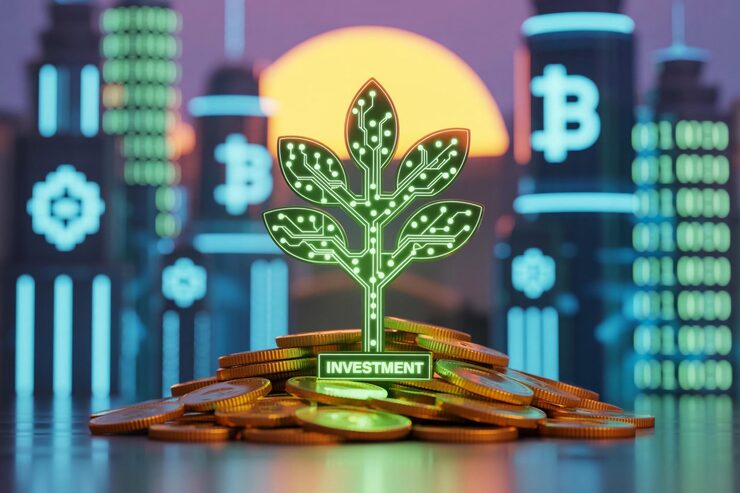Blockchain Revolution
Ending Carbon Credit Fraud Forever

The carbon credit market has a dirty secret: nobody really trusts it.
Despite growing to a multi-billion-dollar industry, carbon markets have been plagued by scandals that read like corporate thriller novels. Credits sold multiple times to different buyers. Forestry projects that never existed. Emissions reductions were already happening anyway. The result? A crisis of confidence that threatens to undermine one of our most important tools for fighting climate change.
But there's a technology revolution happening that could change everything: blockchain. The same distributed ledger technology that powers cryptocurrencies is now being deployed to bring transparency, traceability, and trust to carbon markets. The question is, can it actually deliver on this promise, or is it just another tech buzzword being thrown at a complex problem?
Blockchain’s Power in Carbon Markets
Carbon credits, each representing one tonne of CO2 reduced or removed, allow businesses to offset emissions. Traditional registries, often centralized, are prone to errors and manipulation. Blockchain changes the game with a decentralized ledger, where each credit is a unique digital token. Every transaction, from issuance to retirement, is recorded across a network, transparent to all, unalterable by any.
In 2025, blockchain ensures additionality, proving reductions exceed standard practices, and permanence, locking carbon away long-term. Blockchain enhances traceability and can reduce verification overheads, though its impact on costs and credit premiums varies widely across pilot programs.
Real-World Breakthroughs: Blockchain in Action
Several organizations including the UNFCCC’s Climate Ledger Initiative, IOTA Foundation, and Energy Web are piloting blockchain for digital MRV and tokenization, though large-scale registry adoption remains limited.
Verra, a top carbon standard, piloted blockchain in 2023 for a Peruvian Amazon reforestation project, tokenizing 1 million tonnes of CO2 credits. Buyers tracked each credit from forest to retirement, boosting sales by 25 percent and slashing fraud risks. Gold Standard tokenized credits from a 50-megawatt solar project in Rajasthan, India, in 2024. Tied to live energy output, these credits attracted 3 million dollars from European firms like BP, with verification times dropping from weeks to hours.
These projects, from China’s winds to India’s sun, prove blockchain turns credits into trusted assets, fueling voluntary market growth.
Ending Fraud: Blockchain’s Core Strengths
Fraud has bled carbon markets, with double-counting and overclaiming costing billions yearly. Blockchain’s immutability locks data, preventing tampering. In 2024, a Blockchain platform with Pilot platforms such as Energy Web and Toucan have demonstrated how transparent ledgers could flag duplicate credits, but large-scale independent validation remains ongoing.
Encryption secures sensitive data while enabling audits, aligning with standards like ISO 14064. Scalability is advancing, with layer-2 solutions like Polygon handling thousands of transactions per second, making blockchain viable for global markets. This efficiency cuts verification costs by 20 percent, spurring adoption in developing nations.
Challenges and Solutions

Blockchain faces obstacles. Early proof-of-work systems were energy-intensive, but 2025’s proof-of-stake models cut consumption by 99 percent. Regulatory gaps linger, with only 35 percent of countries having blockchain guidelines for carbon credits. Interoperability issues affect 30 percent of projects, as legacy registries struggle to sync with blockchains. Hybrid platforms, adopted by 20 registries in 2025, bridge this gap.
Setup costs, ranging from 10,000 to 50,000 dollars, challenge small projects. Subsidies in the EU and India, covering 40 percent of costs, ease this burden. By 2026, 60 percent of carbon registries plan blockchain integration, driven by standardized protocols from groups like the Climate Chain Coalition.
The 2025 Outlook: Blockchain’s Rising Tide
Blockchain is reshaping carbon markets. In 2025, As of 2025, less than 10 % of voluntary credits are digitally tokenized, though growth is accelerating through pilots across Asia and Europe.
Developing nations benefit too. Kenya’s 2024 reforestation credits, tokenized for 10,000 hectares, generated 2 million dollars for communities, supporting India’s 2070 net-zero goal. Blockchain’s scalability and trust make it a cornerstone for global climate action.
Why Transparency Matters
Transparency fuels carbon markets. Investors, injecting 40 billion dollars into credits in 2024, prioritize trust, with 75 percent demanding blockchain verification. This curbs greenwashing, which cost firms 10 percent in reputation value last year. Transparent credits boost ESG ratings, unlocking 1.4 trillion dollars in sustainable finance. The EU’s 2025 Emissions Trading System reforms lean on blockchain, while India’s BRSR encourages it for Scope 3 reporting, driving real climate impact.
The Path for Businesses

To lead in 2025, businesses must adopt blockchain. Partner with registries like Verra or Gold Standard for tokenized credits. Integrate blockchain into supply chains for Scope 3 tracking, saving 25 percent in costs. Collaborate with tech providers for scalable solutions. This positions firms as sustainability leaders, meeting investor demands and net-zero targets while accessing the EU’s 1.5 trillion euro market.




